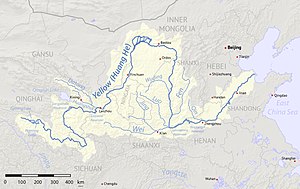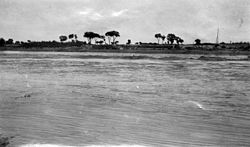Fen River
| Fen River | |||||||||
|---|---|---|---|---|---|---|---|---|---|
 TheYellow River Basin,with the Fen on the right, joining the south-flowing Yellow River just above its eastward turn | |||||||||
| Chinese | PhầnHà | ||||||||
| |||||||||
| Ji River | |||||||||
|---|---|---|---|---|---|---|---|---|---|
| Chinese | CơThủy | ||||||||
| |||||||||


TheFen Riverdrains the center ofShanxi Province,China.It originates in theGuancen MountainsofNingwu Countyin northeast Shanxi, flows southeast into the basin ofTaiyuan,and then south through the central valley ofShanxibefore turning west to join theYellow Riverwest ofHejin.The Fen and theWei Riversare the two largest tributaries of the Yellow River. The river is 694 kilometers (431 mi) long and drains an area of 39,417 km2(15,219 sq mi), 25.3% of Shanxi's area. The Fen River is the longest in Shanxi. It is also the second-longest tributary of theYellow River.WithinTaiyuan,the Fen runs from north to south; the prefecture includes one-seventh of the river's course.
History[edit]
Legend[edit]
The Fen is usually identified with theJi Riversaid bySima Qianand others to have flowed beside the home of theYellow Emperor.[1]TheDiscourses of the Statesstates that the Ji was the home of the Yellow Emperor's clan before he fought the clan ofYandi(the "Flame Emperor" ).[2]Its name is identical withthe surname of the royal familyunder theZhou.Pulleyblankargues, however, that the supposed "Ji River" could be a later invention as "there seems to be no record of a Ji River outside the myth" of the Yellow Emperor.[2]
Ancient[edit]
The lower Fen was part of the core area of ancient China and held the capital of thestate of JinnearHouma.The river nurtured the 2500-year-oldSanjin Civilizationand has since been called the "Mother River of People" inShanxi.[citation needed]
InTaiyuan,the Fen River valley area has fertile water resource; for this reason, the Fen area has become the economic center ofShanxiprovince. There are two valleys of the south region of further south. One of the valleys is the Fen River valley, it had led to theYellow River.The second valley is the Su River, which was along the north edge of Zhongtiao Mountain; and it was forming another triangular basin. The Fen River valley offered different routes of communication in Wei River valley, that both routes were open to the either side of theYellow River.[3]
Modern[edit]
Modern cities on or near the Fen from north to south are:Taiyuan,Linfen,Houma,Hejin.Fenyang,although named after the river, is actually some 20-plus km to the west of it.
As with any river that flows through a city, the Fen River added extra charm to the city ofTaiyuan.The construction of dams upstream, however, reduced the once-abundant flow of the river to a mere trickle, and the river bed went dry. From 1949, Chinese government built the reservoirs such as Fen River, Wenyu River, Hui River, and several other reservoirs on the tributaries of the Fen River, which ensuredTaiyuancity and other cities’ industrial water, and enlargedTaiyuanbasin andLinfenbasin's irrigation.[4]Before the 1950s, Fen River valley's flood areas is 13.34 ten thousand hectares, saline-alkali soil is 6.67 ten thousand hectares. Today, due to the influence of the water conservancy facilities, the water logging is almost inexistence, huge areas of saline-alkali soil are reformed.
Surrounding Introduction[edit]


In the 1990s, the municipal government ofTaiyuanbuilt artificial and removable structures across the river at different locations to create reservoirs of water for landscaping purposes. The surface area of these reservoirs amounts to 1.7 million square meters and, along with newly createdvegetationof 1.3 million square meters on the banks, forms the 6-kilometer longFen River Park.The vegetation consist of 183 species trees, shrubs and other green plants.
The No. 1 Fen River reservoir, built in 1960, is the biggest artificial reservoir inShanxiprovince; it is also the scenic spot in the province. The length from south to north is 15 kilometers, the width is 5 kilometers, the total area is 32 square kilometers, and the capacity of reservoir is 720 million cubic meters. In 2000, the No. 2 Fen River Reservoir was built about 50 kilometers downstream the No. 1 Fen River Reservoir. The pollution of Fen River reservoir has become a serious problem.[5]Because of the rise of population and the development of economy, the industrial, domestic, and other kinds of pollution have been on the rise. Great quantities of sewage are indiscriminately discharged into the riverbed downstream of the No. 1 and 2 reservoirs. However, the government is trying to fix the problem.[6]
See also[edit]
References[edit]
Citations[edit]
- ^Pulleyblank (2000).
- ^abPulleyblank (2000),p. 14.
- ^Feng, Li (2006-08-17).Landscape and Power in Early China: The Crisis and Fall of the Western Zhou 1045–771 BC.Cambridge University Press.ISBN978-1-139-45688-3.
- ^Beighley, R. Edward; Killgore, Mark W. (2011-05-23).World Environmental and Water Resources Congress 2011: Bearing Knowledge for Sustainability.American Society of Civil Engineers.ISBN978-0-7844-7662-8.
- ^Yu, Yuanxu; Yu, Zhengtao; Zhao, Jingying (2011-07-18).Computer Science for Environmental Engineering and EcoInformatics: International Workshop, CSEEE 2011, Kunming, China, July 29-30, 2011. Proceedings.Springer Science & Business Media.ISBN978-3-642-22693-9.
- ^Falke, Matthias. “The Fen River in Taiyuan, China: Ecology, Revitalization, and Urban Culture.” Environment & Society Portal, Arcadia (Autumn 2016), no. 17. Rachel Carson Center for Environment and Societyhttps://doi.org/10.5282/rcc/7679
